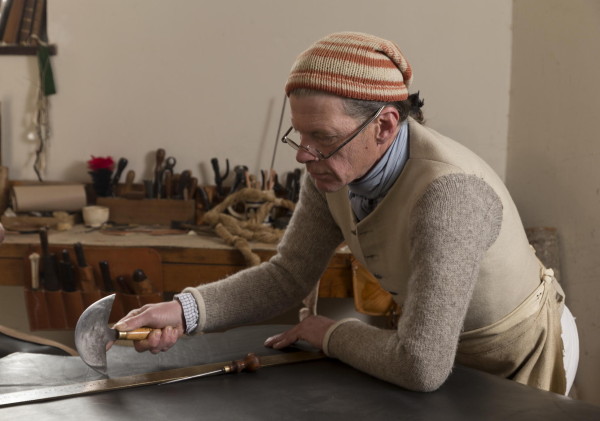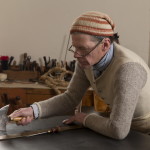The sign reads simply, “artificer shop.” An arrow points behind the Magazine. Halfway around the octagon, a door opens to a shop where Jay Howlett has been plying his trade for five years. [Ed. note: In summer months the artificer’s shop moves to a building behind Anderson’s Blacksmith Shop.]
So what is an artificer? “A lot of times that’s my opening because it’s the first thing people will ask,” says Howlett.
“Anyone who performs any skilled labor can be termed an artificer. By the 18th century, we see that word most consistently in a military context. So really it’s anyone who is providing skilled labor for the army.”
“Strictly speaking, the tin men, the wheelwrights, the armoury staff are all artificers. It’s not specific to the kind of work I do; it’s all of us that provide skilled labor to the army.”
According to Howlett, the artificer position disappeared in the U.S. army in the late 1800s but continued to be used elsewhere. “I had a gentleman in the shop just the other day who retired from the British Navy with that as his job classification.”
The artificer’s workroom
The artificer is included in a picture book celebrating Colonial Williamsburg Historic Trades, the largest, most diverse museum-operated trades program in the world, with the Foundation’s wonderful photography. Learn more here.
Within the Magazine, Howlett and two dedicated volunteers, Jan Tilley and Chuck Wood, are responsible for the upkeep of everything from cartridge pouches to cavalry equipment.
They work with leather, textiles and fiber items. “The work is incredibly variable. I could be dressing hats. I could be making knapsacks. I could be doing luggage. There’s way more work than we’ll ever catch up with.”
The artificers also support other trade shops with leatherwork including bellows, belts for lathes, upholstery and machine fittings.
Much of the work involves working with leather and relates to military programs, Revolutionary City or the Fifes and Drums.
“I take care of all the Fife and Drum Corps belts, and all of their carriages and fife cases,” says Howlett. “I take care of presentation hats for their leaders. I just did a whole pile of sword belts for the Revolutionary City actors.”
“Ears deep” with George
For two years, Colonial Williamsburg’s many trades have been at work in a major collaboration with the Museum of the American Revolution to re-create George Washington’s military encampment as commander of the Continental Army — from the marquee (we would call it a tent) to all the furniture and supplies within the mobile headquarters.
“We’ve been ears deep on the edges of the First Oval Office project, reproducing all of Washington’s camp gear,” he says.
The artificer’s shop produced all of the seats for Washington’s camp stools and a number of large valises to hold the tent.
Now they are in the process of reproducing the “canteens.”
“They are sort of a combination travel bar and spice cabinet,” explains Howlett. “It looks kind of like a knapsack with a big collapsible pocket on the front. It’s got a wooden body, all upholstered, with a leather flap and hasp, and it’s made to strap one on either side of a saddle.”
“Eventually we’ll probably try to reproduce all of Washington’s surviving camp equipment.”
The trade in 18th century Williamsburg
Howlett traces the roots of his shop to revolutionary Williamsburg. “There was a public leather factory here in town that employed 16 men for years and years.
“But because of Williamsburg being the capital there were some pretty specific hands involved in the work here. The state regiment of artillery that is raised to help garrison Williamsburg, York, Hampton and Portsmouth, has a dedicated company of artificers attached to it.”
Capt. Lawrence Howse led the detachment in Williamsburg from February 1778 until the capital moved to Richmond in 1780.
“There’s some information pointing to the leather factory being in the Raleigh Tavern because we know it was in a building rented by James Southall. He has a bunch of property, and he’s renting a bunch of it to the government during those war years.
“But the tavern is closed, so there’s some supposition that [it was the location of] the public leather factory, which is turning out shoes and modifying saddles, for example. The superintendent is being ordered to buy deerskins for cavalry breeches, so they’re doing quite a variety of work. In our shop what we’re doing is almost anything in leather or textiles.”
Steeped in history
“Artificer” is even less likely to show up on career aptitude tests than blacksmith or weaver. So how did Howlett end up in that position?
“I can barely remember a time I wasn’t doing this. I grew up in upstate New York, and I grew up in a place that you really couldn’t swing a dead cat without hitting a battlefield.” As a child, Howlett recalled his brother twisting his ankle when he stepped on a three-pound cannonball from the Revolutionary War era. “It was probably dropped by Burgoyne’s army going over to Bennington,” he surmises.
“I was just the right age to get involved in bicentennial stuff, so I started doing re-enactments as a drummer when I was 12. I was working at Saratoga by the time I was 14.”
“I was also trained as a chef, so it was easy. I worked at historic sites in the summer and cooked at ski resorts in the winter.”
When Howlett spent his honeymoon in Williamsburg, he thought to himself, “I can do that.”
Sixteen years ago Howlett was hired to work in the Raleigh Tavern. He considered it a foot in the door on the way to a position in historic trades.
He spent nine years in the saddle shop until it was shut down five years ago.
“When the saddle shop was closed, I really had to reinvent my position,” says Howlett. “Somehow I wound up assigned to military programs, so I had to sort of reinvent the trade.” He dove into historical research and came out with a plan to interpret the artificer.
“I had been working at military sites since the ‘70s, and we had always done some military items in the saddle shop, so this wasn’t a huge stretch. It wasn’t that hard to find leather and textile items to work with.”
The transition was made easier with the introduction of enhanced military programming, particularly Revolutionary City and the construction of the armoury complex.
What’s on the bench
Howlett hopes for lots of questions when a guest finds his shop. “What’s on the bench at a given time is usually going to fuel what we talk about.”
“Right now I’ve got to replace the crown piece to a bridle, make a whole bunch of circular spots for the Powell House, and there’s always a pile of cartridge box pieces that eventually are going to need to be put together. I’ve got one of the Washington canteens to finish, so there’s always work going on.”
Howlett is optimistic that a new generation with a keen interest in making things by hand is emerging. He believes all the students bringing their cellphones and iPods to the shop may be paying more attention than you might think.
“When students come and see how it really was, I think that’s the appeal, and I think it’s only going to grow. As we become more and more technology dependent, I think that handwork is going to have a lot more appeal because of the novelty of it.”
Howlett points to examples of the maker movement where you’ll find young people interested in custom-made suits, raising chickens or growing their own food.
Which may forecast the next generation of historic interpretation in Williamsburg.


Ms Marty Hiatt says
This is the best, most reasonable explanation of the term artificer. Thant you!